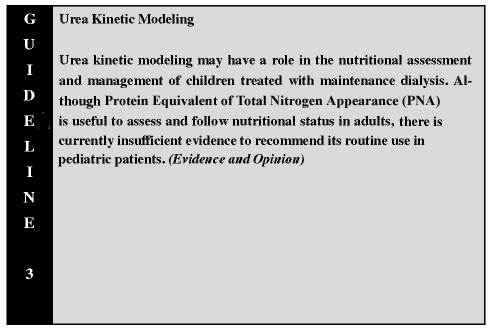

Urea kinetic modeling is an important tool in the measurement of dialysis delivery and, therefore, for the assessment of dialysis adequacy.23 However, there are limited data that clearly and definitively correlate PNA (or protein catabolic rate [PCR]) to dietary intake and to nutritional outcomes in children receiving MD.
A correlation between measured net PNA and the combination of urea generation rate and body weight has been demonstrated in children treated with HD.24 In a prospective study on two children undergoing HD, kinetically determined PNA increased from 0.8 to 1.1 g/kg/d when protein and energy intake were increased in one subject, with a consequent 78% increase in nitrogen balance. The second child was given additional nonprotein calories, and the kinetically derived PNA decreased from 1.22 to 0.81 g/kg/d, with a 257% increase in nitrogen balance.25
A correlation has also been shown between protein balance (dietary protein intake [DPI] from diet diaries minus the kinetically derived PNA) and energy intake in children treated with maintenance hemodialysis (MHD).26 PNA alone did not correlate with either protein intake or energy intake for the group as a whole. When subdivided by nitrogen balance, a correlation with PNA did exist. Children in positive nitrogen balance had lower PNAs than did children in negative nitrogen balance.26 However, 10 of the 43 balance periods had PNA values not anticipated by the children's protein and energy intake. Knowledge of either PNA or protein intake alone was felt to be insufficient to predict the protein balance of children.26 Recently, the combination of increased dialysis and adequate nutrition have been shown to have a beneficial effect on growth in children undergoing MHD.27 Moreover, the characteristics of peritoneal solute transport may play a role in growth and nutritional status in children treated with MD.28
Studies performed in seven children on automated peritoneal dialysis showed no correlation between Kt/V and DPI or between normalized PNA (nPNA) and DPI. There was a correlation between Kt/V and energy intake.29 An additional study was performed in 12 children undergoing continuous ambulatory peritoneal dialysis (CAPD) and eight children undergoing continuous cyclic peritoneal dialysis (CCPD). DPI was reported to be higher in the children treated with CCPD. The two groups had equal weekly total creatinine clearances (57 L/wk/1.73 m2), but the children treated with CCPD had a mean weekly total Kt/V urea that was greater than those on CAPD (2.45 versus 1.75).30
Despite the information provided in these studies, there is insufficient evidence at this time to recommend the routine determination of PNA (nPNA) as a means of nutritional assessment in children.